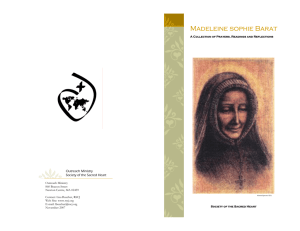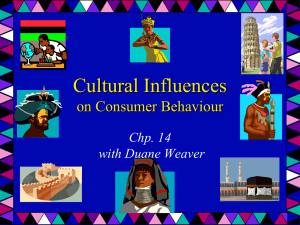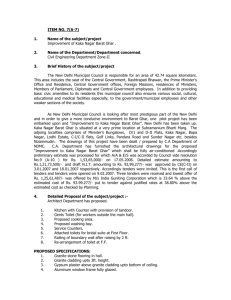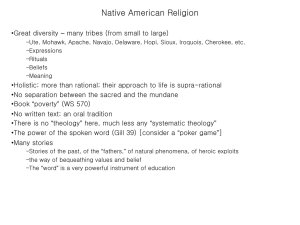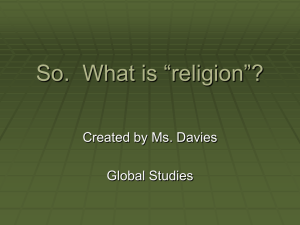Phil Kilroy, The Society of the Sacred Heart in Nineteenth
advertisement
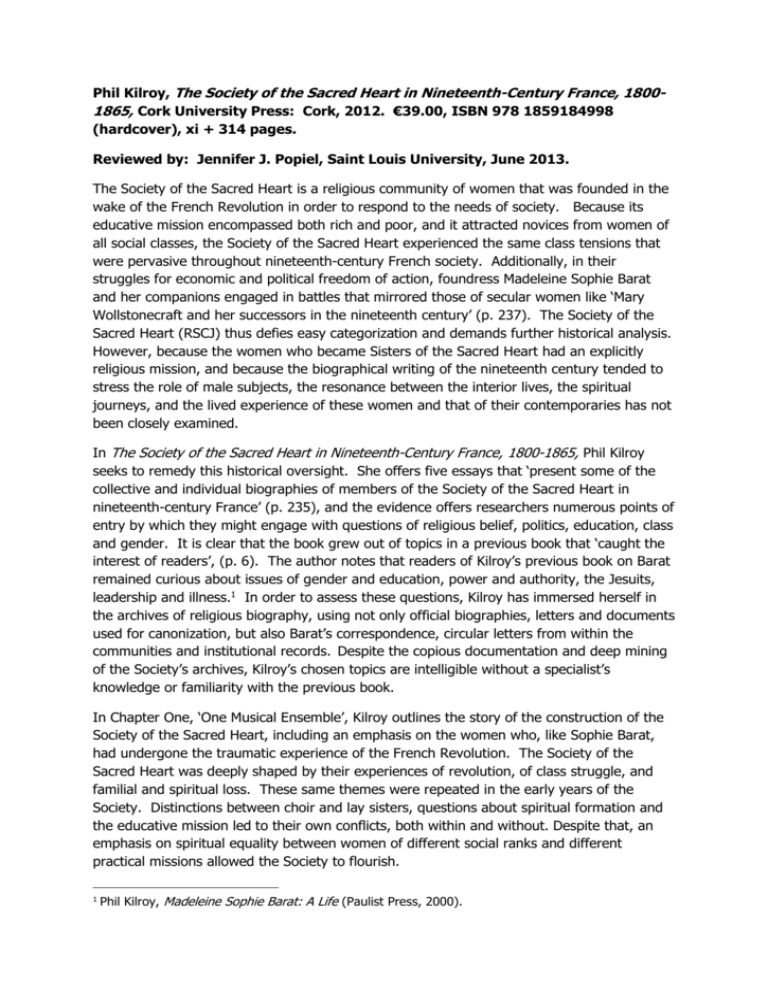
Phil Kilroy, The Society of the Sacred Heart in Nineteenth-Century France, 18001865, Cork University Press: Cork, 2012. €39.00, ISBN 978 1859184998 (hardcover), xi + 314 pages. Reviewed by: Jennifer J. Popiel, Saint Louis University, June 2013. The Society of the Sacred Heart is a religious community of women that was founded in the wake of the French Revolution in order to respond to the needs of society. Because its educative mission encompassed both rich and poor, and it attracted novices from women of all social classes, the Society of the Sacred Heart experienced the same class tensions that were pervasive throughout nineteenth-century French society. Additionally, in their struggles for economic and political freedom of action, foundress Madeleine Sophie Barat and her companions engaged in battles that mirrored those of secular women like ‘Mary Wollstonecraft and her successors in the nineteenth century’ (p. 237). The Society of the Sacred Heart (RSCJ) thus defies easy categorization and demands further historical analysis. However, because the women who became Sisters of the Sacred Heart had an explicitly religious mission, and because the biographical writing of the nineteenth century tended to stress the role of male subjects, the resonance between the interior lives, the spiritual journeys, and the lived experience of these women and that of their contemporaries has not been closely examined. In The Society of the Sacred Heart in Nineteenth-Century France, 1800-1865, Phil Kilroy seeks to remedy this historical oversight. She offers five essays that ‘present some of the collective and individual biographies of members of the Society of the Sacred Heart in nineteenth-century France’ (p. 235), and the evidence offers researchers numerous points of entry by which they might engage with questions of religious belief, politics, education, class and gender. It is clear that the book grew out of topics in a previous book that ‘caught the interest of readers’, (p. 6). The author notes that readers of Kilroy’s previous book on Barat remained curious about issues of gender and education, power and authority, the Jesuits, leadership and illness.1 In order to assess these questions, Kilroy has immersed herself in the archives of religious biography, using not only official biographies, letters and documents used for canonization, but also Barat’s correspondence, circular letters from within the communities and institutional records. Despite the copious documentation and deep mining of the Society’s archives, Kilroy’s chosen topics are intelligible without a specialist’s knowledge or familiarity with the previous book. In Chapter One, ‘One Musical Ensemble’, Kilroy outlines the story of the construction of the Society of the Sacred Heart, including an emphasis on the women who, like Sophie Barat, had undergone the traumatic experience of the French Revolution. The Society of the Sacred Heart was deeply shaped by their experiences of revolution, of class struggle, and familial and spiritual loss. These same themes were repeated in the early years of the Society. Distinctions between choir and lay sisters, questions about spiritual formation and the educative mission led to their own conflicts, both within and without. Despite that, an emphasis on spiritual equality between women of different social ranks and different practical missions allowed the Society to flourish. 1 Phil Kilroy, Madeleine Sophie Barat: A Life (Paulist Press, 2000). In Chapter Two, ‘The Story of the Sacred Heart’, Kilroy examines the educative model, especially as it was conceived by Marie d’Olivier, who offered numerous pedagogical directives to Sophie Barat. Though Olivier ultimately left the Society of the Sacred Heart over a conflict in the direction of the Society’s educational plans, she continued to feel close ties to the Society, even until her death. The most substantial part of the chapter consists of educative texts composed by Olivier. Historian Rebecca Rogers contextualizes and comments on these texts, pointing out how a limited project of moral reform within the family might also provide a ‘cadre of women teachers, whose influence would spread around the globe’. (p. 131) Chapter Three, ‘The Society of the Sacred Heart and the Jesuits in the Lifetime of Madeleine Sophie Barat’ focuses not only on the success of the Society of the Sacred Heart, but its relationship to the Society of Jesus. The close ties between the two made for complicated politics. Even as Barat used the guidance and international network of the Jesuits, she attempted to keep the RSCJ’s spiritual goals, including their freedom from cloister, independent of the goals that the Jesuit leadership – and their allies within the Society – would set for them. Given the close relationships between Jesuits and some of the RSCJ leadership such as Elizabeth Galitzine and Louis de Limminghe, this was not always an easy task, either personally or professionally. Chapter Four, ‘Medical Biography in the Society of the Sacred Heart’, gives an overview of Sophie’s medical history and relates it to her spiritual journey. It demonstrates her concern for the health and well-being of the Society’s members and how Sophie Barat suffered from chronic health problems that left her incapacitated and unable to pursue as active a role as she might have wished, especially in the winter months. Frederick Holmes and Mary d’Apice offer a diagnosis of Sophie’s physical and psychological infirmities. The chapter’s emphasis on the medical history of Sophie Barat demonstrates that Sophie’s bodily weakness forced her to seek balance in her life and ultimately became a source of spiritual strength. Chapter Five, ‘The Spiritual Leadership of Madeleine Sophie Barat’, takes the individual circles of the preceding chapters and ties them together into an overall assessment of Barat’s impact on the Society that she founded. Ultimately, it traces the evolution and success of the Society to Barat’s own spiritual journey, seeing her as a leader who was fully present to and yet also able to transcend the moment in which she lived. If it is true that, over the course of the nineteenth century, ‘the church familiar to Sophie Barat and her companions in 1800 had disappeared’, (p. 237) Kilroy’s book seems to demonstrate that at least some of the changes may have been ones that offered women more agency and were due, at least in part, to work like that done by the RSCJ. While each individual chapter is well-documented, the ultimate effect of the Society of the Sacred Heart was to leave this reader feeling a bit unfulfilled and wishing that the book had a stronger unifying framework. The chapters do not always easily flow from one to the next and sometimes repeat significant details or quotations (for example, the same block quotation appears on pages 59-60 and page 152). Most significantly, the source material, while useful and interesting, too frequently causes the narrative flow to fade away. This is especially true when there are long sequences, like the educational plans of Marie d’Olivier, or the medical symptoms of Sophie Barat, that are inserted into the text without comment or integration. Ultimately, Kilroy offers the reader an exceptional glimpse into the nineteenth-century struggles, life and vision of the Society of the Sacred Heart. However, the richness of that source material left this reader wishing that she had taken a firmer hand with her sources and left fewer pieces to stand on their own, making them into a “musical ensemble” of their own.


